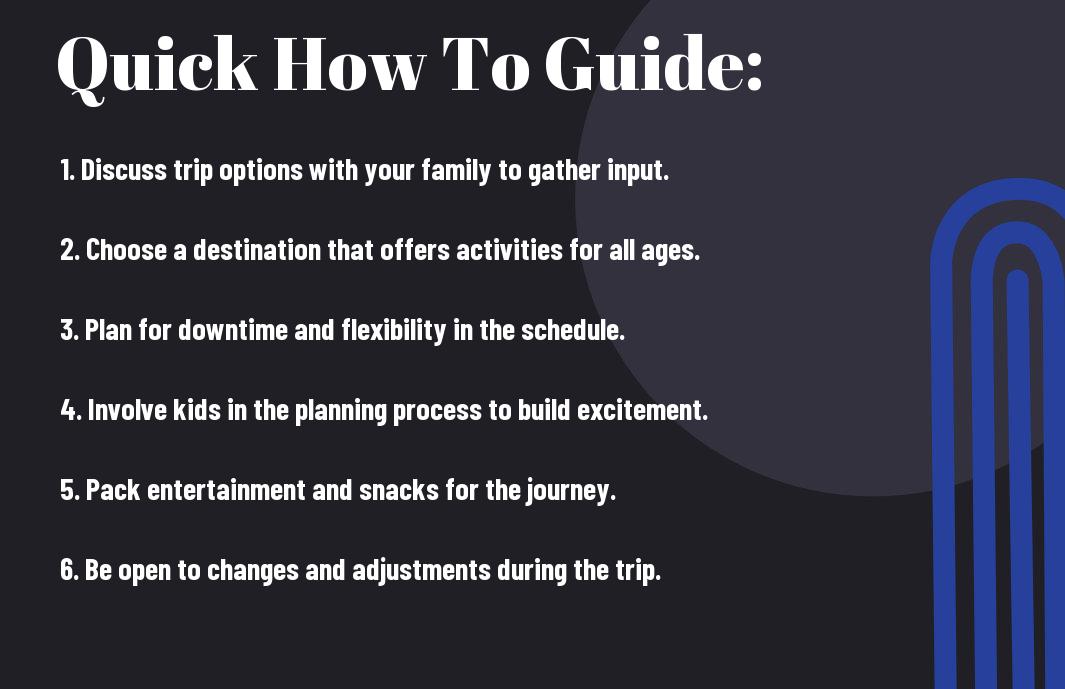Embarking on a family trip can be a challenging endeavor, especially when young children are involved. The key to successful family travel lies in flexibility and careful planning. In this guide, we will provide you with essential strategies to ensure a smooth and enjoyable vacation for you and your little ones. From choosing the right destination, to creating a flexible itinerary, to packing effectively, we’ve got you covered. Say goodbye to overwhelming meltdowns and hello to unforgettable family memories!
Key Takeaways:
- Involve your kids in the planning process: By involving your kids in the planning process, you can give them a sense of responsibility and make them feel more invested in the trip.
- Be flexible with the itinerary: Allow room for spontaneity and adjust the schedule based on your kids’ energy levels and interests. This will help minimize stress and ensure a more enjoyable experience for the whole family.
- Choose kid-friendly accommodations and activities: Prioritize accommodations and activities that cater to your kids’ needs and preferences to keep them comfortable and engaged throughout the trip.
- Bring necessary supplies and entertainment: Pack essential items such as snacks, games, and entertainment to keep your kids entertained during travel and downtime. This will help prevent boredom and tantrums.
- Take breaks and downtime into consideration: Plan for regular breaks and downtime to allow your kids to recharge and avoid overwhelming them with a packed schedule. This will create a more relaxed and enjoyable experience for everyone.

Understanding The Basics
Any well-planned family trip starts with a solid understanding of the basics. For parents, this means taking the time to Avoid Vacation Frustration: 6 Tips to Stay Sane with the Kids before embarking on the journey. This will set the tone for a smooth and enjoyable experience for the whole family.
Knowing Your Travel Party’s Needs and Limits
Knowing your travel party’s needs and limits is essential when planning a family trip. Take into consideration the ages and interests of your children, as well as any health concerns or special requirements. This will help you determine the best destinations, accommodations, and activities that will suit everyone’s needs and ensure a relaxing and enjoyable experience for all.
Understand that every member of your travel party may have different needs and limits, so it’s crucial to find a balance that will cater to everyone’s well-being and enjoyment. By considering these factors, you can anticipate and address any potential issues before they arise, creating a smoother and more enjoyable travel experience.
Establishing Realistic Expectations
To make the most out of your family trip, it’s important to establish realistic expectations from the start. This can include setting realistic timelines for activities, understanding that unexpected situations may arise, and being open to adjusting plans as needed. Communicate openly with your children about the trip’s itinerary, so they know what to expect and feel included in the planning process.
This will help minimize stress and frustration during the trip, as everyone will have a clear understanding of what to expect. Flexibility is key, and by setting realistic expectations, you’ll be better equipped to address any changes or challenges that may arise.
Pre-Travel Preparation
Despite the excitement of planning a family trip, it’s crucial to carefully prepare and organize to ensure a stress-free holiday for all. To help you get started, refer to How To Plan A Family Vacation: A Helpful Checklist to optimize your pre-travel planning.
Picking The Right Destination
Picking the right destination for a family trip can be a daunting task. Consider your children’s preferences and ages, and select a location with family-friendly activities and amenities. Whether it’s a beach resort, a theme park, or a nature retreat, ensure that the destination has something for everyone to enjoy.
When selecting a destination, keep in mind the travel time and distance from your home. Opt for a location that isn’t too far away to minimize travel-induced stress for your little ones.
Crafting a Flexible Itinerary
Crafting a flexible itinerary is essential for a successful family vacation. Plan a balance between adventure and relaxation, making sure to include downtime for rest and recovery. Encourage your kids to participate in the planning process and consider their inputs when structuring the itinerary.
Right from the beginning, set realistic expectations about the daily schedule, and be prepared to make spontaneous adjustments. Embrace the concept of “go with the flow” to allow for unexpected experiences and discoveries.
For young children, having a predictable routine can provide a sense of security. However, this doesn’t mean that every minute of the day needs to be planned. Flexibility is key to accommodating unforeseen circumstances while maintaining a sense of structure.
Tips for Packing Light and Smart
For families, packing light is essential to avoid cumbersome luggage and unnecessary stress. Start with a packing list and include only the essentials. Focus on versatile clothing items that can be mixed and matched, and consider the activities you’ll be engaging in at your destination.
- Roll clothing items to save space and minimize wrinkles.
- Use packing cubes to organize and compartmentalize belongings.
- Maximize carry-on space for important items such as medications, entertainment for the kids, and essential toiletries.
This approach not only simplifies the packing process but also streamlines your travel experience. The goal is to pack efficiently, with the focus on convenience and practicality.

During The Trip
Not only is planning a trip with the family a task in itself, but staying flexible during the trip is also necessary to ensure a smooth and enjoyable experience for everyone involved. In this chapter, we will discuss how to balance scheduled activities and free time, as well as how to adapt when things don’t go as planned.
Balancing Scheduled Activities and Free Time
On a family trip, it’s important to strike a balance between scheduled activities and free time. While it’s good to have a rough itinerary and scheduled outings, it’s equally important to allow for some flexibility in your plans. Over-scheduling can lead to burnout, especially for kids, so be sure to incorporate downtime and spontaneous activities into your itinerary. This will give your family the opportunity to relax, explore, and make unexpected discoveries.
Furthermore, having a flexible mindset when it comes to planned activities will enable you to adapt to unforeseen circumstances or changes. Be open to adjusting your plans based on the interests and energy levels of your children, and don’t be afraid to leave some room for impromptu adventures.
How To Adapt When Things Don’t Go As Planned
Scheduled activities may not always go as planned, and that’s okay. Being prepared for unexpected changes or hiccups in your itinerary will help you handle such situations with ease. Embrace the opportunity to turn a disruption into a positive experience. Take the chance to teach your children important lessons about flexibility and adaptability, and encourage them to see the positive side of unexpected changes.
While it’s important to have a general plan in place, it’s equally crucial to remember that things may not always go according to that plan. Embracing flexibility and remaining positive when things don’t go as expected will not only help keep the trip enjoyable but will also create lasting memories for you and your family.
Engaging and Entertaining Kids on The Go
To ensure that your family trip is enjoyable for everyone, it’s crucial to keep your kids engaged and entertained throughout the journey. With the right mix of activities and technology, you can create a fun and interactive travel experience that will keep your kids happy and occupied, allowing you to focus on the road ahead.
Quick and Easy Travel Games
For a quick and easy way to keep your kids entertained while on the go, consider introducing travel-friendly games such as “I Spy,” scavenger hunts, or simple card games. These activities are not only entertaining but also help to foster creativity and critical thinking skills in your children.
Harnessing Technology for Educational Experiences
Experiences through technology can also be educational. Tablets, smartphones, and other electronic devices can be loaded with educational games, interactive books, and language learning apps to provide your children with engaging and enriching experiences while on the go.
This modern approach to learning can create opportunities for skill development and knowledge acquisition in a way that is fun and appealing to kids. It also allows you to integrate educational experiences seamlessly into your travels without the need for bulky books or additional gear.
Final Words
Presently, planning a family trip that is enjoyable for both parents and kids requires a great deal of flexibility. By taking the time to research and plan ahead, setting realistic expectations, and being open to spontaneous changes, you can create a trip that is both enjoyable and memorable for your entire family. Remember, flexibility is key when it comes to traveling with kids, and being able to adapt to unexpected situations will ultimately lead to a more enjoyable experience for everyone involved. So, embrace the art of flexibility and watch as your family trip becomes a cherished adventure!
FAQ
Q: Why is flexibility important when planning a family trip?
A: Flexibility is important because it allows for unexpected changes, accommodates different preferences, and reduces stress for both parents and children during the trip.
Q: How can I maintain a balance between planning and flexibility?
A: To maintain balance, plan essential aspects such as accommodations and transportation, but keep the daily itinerary open for spontaneous activities and adjustments based on your children’s mood and energy levels.
Q: What are some strategies for involving kids in trip planning?
A: Involving children in planning can create excitement and a sense of ownership. Consider letting them choose a few activities or destinations, incorporating their preferences into the trip’s overall plan.
Q: How can I prepare my kids for unexpected changes during the trip?
A: Discuss potential changes with your kids before the trip, and explain the need for flexibility. Encouraging a positive and adaptable mindset will help them handle unexpected situations with ease.
Q: What are some ways to incorporate downtime into the trip without boring my kids?
A: Consider scheduling short breaks for rest or relaxation between activities. Additionally, incorporating fun downtime activities such as playing games, swimming, or exploring a new playground can keep kids engaged while allowing them to recharge.
Q: How do I handle conflicts or disagreements between family members during the trip?
A: Encourage open communication and compromise. Acknowledge the feelings of each family member and work together to find a solution that satisfies everyone. Setting clear expectations and boundaries beforehand can also help prevent conflicts.
Q: What should I do if my children become overwhelmed during the trip?
A: If your children become overwhelmed, find a quiet and comfortable space to regroup. Take a break from activities, provide reassurance, and offer familiar routines or activities to help them relax and regain their composure.






